| Deep Space: Operation Copernicus | |
|---|---|
 | |
| Publisher(s) | Sir-Tech |
| Platform(s) | Apple II, Commodore 64, MS-DOS |
| Release | 1987 |
Deep Space: Operation Copernicus is a video game published in 1988 by Sir-Tech.
| Deep Space: Operation Copernicus | |
|---|---|
 | |
| Publisher(s) | Sir-Tech |
| Platform(s) | Apple II, Commodore 64, MS-DOS |
| Release | 1987 |
Deep Space: Operation Copernicus is a video game published in 1988 by Sir-Tech.
Deep Space: Operation Copernicus is a game in which the player must use a Katani class ship to eliminate Andromedan warships that have invaded United Planets territory. [1]
David M. Wilson reviewed the game for Computer Gaming World , and stated that "If the game's slow pacing doesn't put the player off initially, the game will give players a competitive run for their money and much potential 'bang for the buck' as the game progresses". [1]
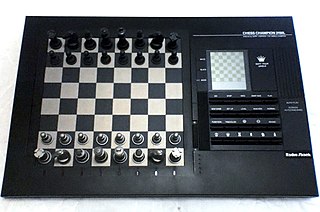
Computer chess includes both hardware and software capable of playing chess. Computer chess provides opportunities for players to practice even in the absence of human opponents, and also provides opportunities for analysis, entertainment and training. Computer chess applications that play at the level of a chess grandmaster or higher are available on hardware from supercomputers to smart phones. Standalone chess-playing machines are also available. Stockfish, Leela Chess Zero, GNU Chess, Fruit, and other free open source applications are available for various platforms.

Sir-Tech Software, Inc. was a video game developer and publisher based in the United States and Canada.

Starflight 2: Trade Routes of the Cloud Nebula is a 1989 science fiction video game developed by Binary Systems and published by Electronic Arts as the sequel to the successful Starflight. It features a combination of space exploration, role-playing and strategy within a futuristic setting. The player commands a spaceship capable of traveling to the game world's 150 solar systems, communicating with or attacking other spaceships, and landing on planetary surfaces which may be explored with a crewed rover for plot clues, minerals and alien lifeforms. Game mechanics and the overall look and feel closely resemble the earlier Starflight game, but many new features are introduced including an interstellar trade-based economy, new sentient alien races, and new spacecraft accessories and artifacts. The player is tasked with discovering the ultimate source of the advanced spacecraft technology and unlimited fuel supply which provide a military advantage to the Spemin, a hostile alien race threatening to annihilate or enslave humanity. A major part of the game consists of earning enough money to pay for spaceship upgrades and crew training by engaging in interstellar trade and barter with various alien cultures at their planetary trading posts.
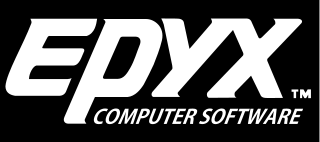
Epyx, Inc. was a video game developer and video game publisher active in the late 1970s and 1980s. The company was founded as Automated Simulations by Jim Connelley and Jon Freeman, originally using Epyx as a brand name for action-oriented games before renaming the company to match in 1983. Epyx published a long series of games through the 1980s. The company is currently owned by Bridgestone Multimedia Group Global.

Reach for the Stars is a science fiction strategy video game. It is the earliest known commercially published example of the 4X genre. It was written by Roger Keating and Ian Trout of SSG of Australia and published in 1983 for the Commodore 64 and then the Apple II in 1985. Versions for Mac OS, Amiga, Apple IIGS, and DOS were released in 1988.

Eastern Front (1941) is a computer wargame for Atari 8-bit computers created by Chris Crawford and published through the Atari Program Exchange (APX) in 1981. A scenario editor and assembly language source code for the game were also sold by APX as separate products.
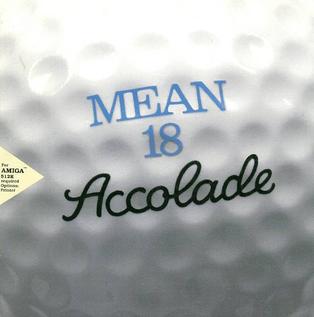
Mean 18 is a golf video game designed by Rex Bradford with graphics by George Karalias, both of Microsmiths, and released by Accolade for MS-DOS compatible operating systems in 1986. It was ported to the Amiga, Apple IIGS, Atari ST, and Macintosh. It includes an editor allowing players to create their own courses. In 1989, Atari Corporation published a port for the Atari 7800 console. A version for Atari 8-bit computers was in development in 1989 but was cancelled.
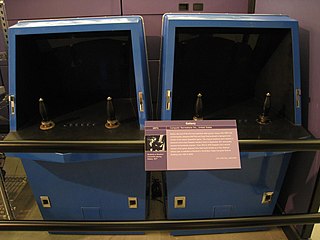
Galaxy Game is a space combat arcade game developed in 1971 during the early era of video games. Galaxy Game is an expanded version of the 1962 Spacewar!, potentially the first video game to spread to multiple computer installations. It features two spaceships, "the needle" and "the wedge", engaged in a dogfight while maneuvering in the gravity well of a star. Both ships are controlled by human players.
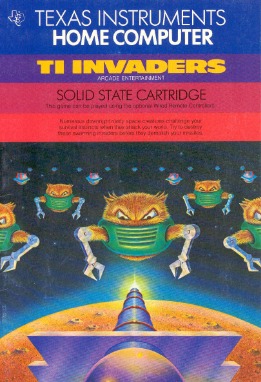
TI Invaders is a fixed shooter video game published by Texas Instruments in 1981 for the TI-99/4A home computer. The game is a Space Invaders clone where the goal is to shoot all of the aliens before they reach the bottom of the screen. TI Invaders is part of the TI Arcade Game Series which includes Tombstone City: 21st Century and Car Wars.

World Tour Golf is a 1986 video game by Evan and Nicky Robinson, Paul Reiche III and published by Electronic Arts for Commodore 64, Amiga, Apple IIGS, and DOS.

World Class Leader Board is a 1987 golf video game published by Access Software. It is part of the Leader Board series.

Risk: The World Conquest Game is a computer wargame developed by Virgin Mastertronic in 1989 for MS-DOS. It is based on the board game Risk.

Psi-5 Trading Company is a 1985 space trading game, one of the first games published by fledgling video game developer and publisher Accolade.

Ellery Queen's Operation: Murder is a murder mystery game published by Spinnaker Software in 1986 that presents a mystery based on The Dutch Shoe Mystery by Ellery Queen.
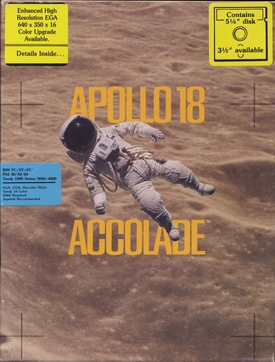
Apollo 18: Mission to the Moon is a 1987 video game published by Accolade and developed by Canadian studio Artech.

Magnetron is a 1988 video game published by Broderbund.

Shirley Muldowney's Top Fuel Challenge is a 1987 video game published by Cosmi Corporation.

Top Fuel Eliminator is a 1987 video game published by Gamestar.

Resolution 101 is a 1990 video game developed by Astral Software and published by Millennium Interactive.